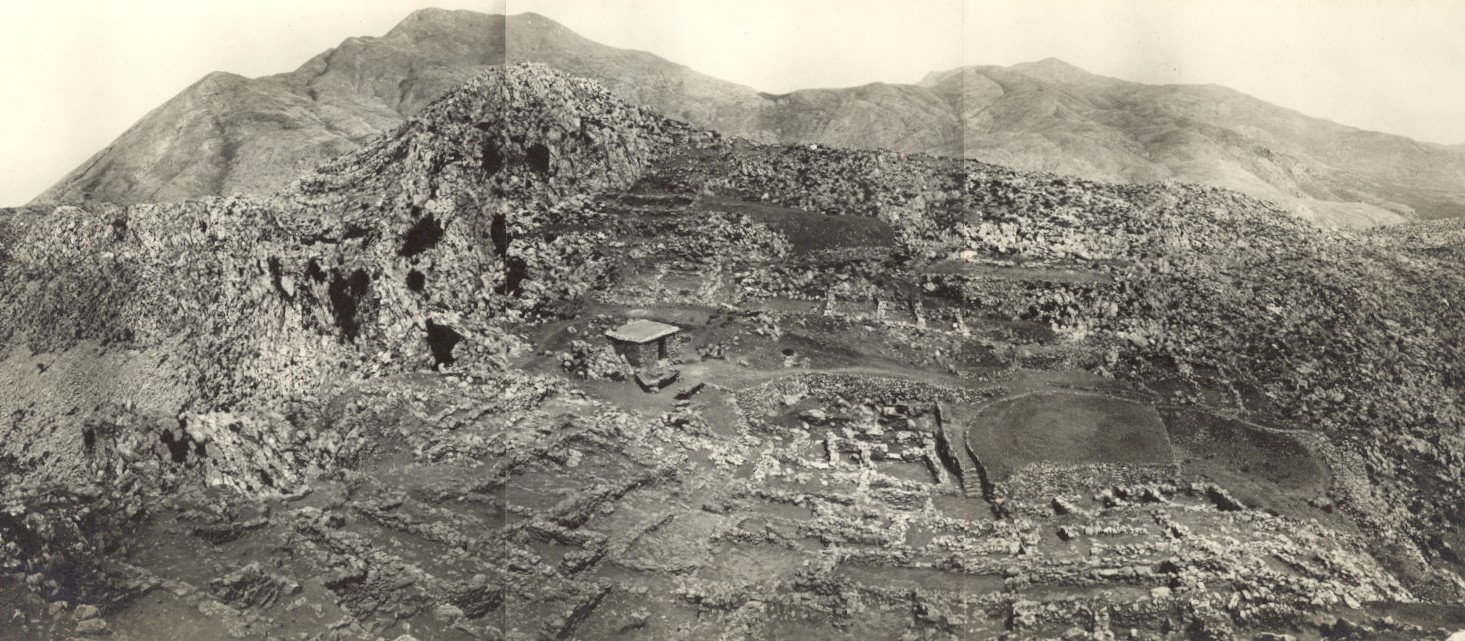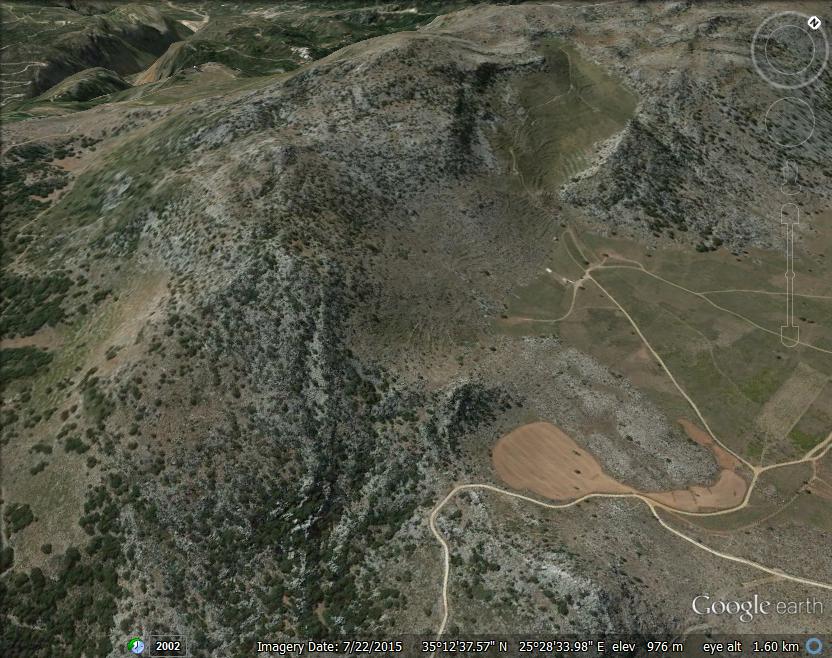Background
A history of work at the site
In 1937, John Pendlebury and team started excavations with the permission of the Greek archaeological authorities via the British School at Athens at the remote and rugged mountaintop site of Karphi, 1140m above sea level in the Lasithi mountains of Crete. The site had previously been reconnoitred by Arthur Evans, who noted the remains of massive buildings between the peaks of Karphi and Mikri Koprana. The result of excavation was the unexpected discovery of the streets, squares, houses, storerooms and shrines of an exceptionally large town, founded here in the mysterious, chaotic era at the end of the east Mediterranean Bronze Age. Pendlebury put together a fairly comprehensive report with schematic site plan and catalogue of the very numerous finds, including some early colour photographs. The finds were taken to the Museum of Heraklion. Pendlebury intended to, and did, complete only the excavation of the saddle area between Mikri Koprana and Karphi (about a fifth of the site's total area) leaving the rest of the site for future research. Work stopped in summer 1939.
In 1960, following Pendlebury's death at the hands of the German Army during the Battle of Crete in 1941, leaving his work , another member of the excavation team, Mercy Money-Coutts, published an overview of the large amount of pottery vessels recovered.
During the 1980s and 1990s, Bogdan Rutkowski and Krzysztof Nowicki with individual permissions from the Greek Ministry of Culture mapped and examined surface remains excavated and unexcavated at the site, with special focus on the Temple. They also undertook extensive landscape survey with separate permissions in the north Lasithi area.
In 2002, Saro Wallace with permissions from the Greek Ministry of Culture via the British School at Athens started detailed planning and building recording on the excavated and unexcavated built remains at Karphi, leading to the improvement of published maps and plans and the preparation of a targeted test excavation in four areas of the wider site. She also carried out a variety of formal and informal surveys (soil, land-use, historic land-use) using permits from IGME (the Greek national authority for geological mapping and sampling). This work was published from 2005: a book-length publication was submitted for publication in 2015 and in 2020 was published by the British School at Athens.
In 2005-11, Professor Leslie Day (Wabash University), excavator of Early Iron Age sites in eastern Crete and a close long-term collaborator with and advisor to Nowicki and Wallace, with the permission of Heraklion Museum via the British School at Athens, studied and published in full the pottery assemblage from Pendlebury's excavations at Karphi, again in a volume within the British School at Athens series.
In 2012-2019 Saro Wallace and colleagues with permissions from Heraklion Museum and the Greek Ministry of Culture via the British School at Athens studied and published or prepared for publication detailed plans of surface remains at Karphi and the neighbouring site of Papoura, and new records and analyses of the metals finds, human remains and selected small finds from Pendlebury's excavations.
In 2021 under the auspices of the British School at Athens Saro Wallace (then Honorary Research Fellow at the University of Manchester) and Ina Berg (University of Manchester) applied to the Greek Ministry of Culture and Sport for permission to restart excavations at Karphi in a 3-year programme. This application cited in its support a formal letter of welcome and offers of assistance from the Demos of the Lasithi Plain. Just before commencement in June 2021 it was indicated that permission was likely to be refused due to local uncertainties about responsibilities and staffing for the protection of the site. Instead, a 6-week field school for students in the project team was run in the Lasithi plain and mountains area.
In 2021 Wallace with Greek collaborators also started a funded programme of ethnography-based research on the nature of opportunities for heritage landscape enhancement and promotion in the area using local communities' knowledge and awareness of that landscape. Associated activities intended to benefit local communities has included the draft preparation of trails leaflets and the design of an archaeological education and research programme in schools aimed at finding out about young people's awareness and understanding of local heritage landscapes and their potential.
In 2022, under the auspices of the Polish Institute of Archaeology and Athens and with the full formal support of the British School at Athens, Krzysztof Nowicki and Saro Wallace applied to the Greek Ministry of Culture and Sport for permission to restart the excavation project for five years 2023-7. Both local demoi (Lasithi Plain and Chersonisos) were informed of this fact. The Demos of the Lasithi Plain had previously offered its full support, and Chersonisos was pleased to welcome the project. After administrative reorganisations, the two relevant archaeological authorities now jointly recognise the area of our archaeological interest as falling within the Chersonisos Demos.
In October 2022 the Demos of the Lasithi Plain (which had in 2018 formally and warmly invited the project's work on mapping, excavation, outreach and educational activities as specified above in a letter from the Mayor), abruptly attempted to stop our educational programme in local schools (which included a walk to Karphi) stating that it was intended to use schoolchildren and their families' knowledge of the local area to search our and exploit archaeological sites for unspecified gain. However, the educational programme had already been completed, carried out with full permissions from the Ministry of Education. Notwithstanding the project's numerous attempts to contact the Demos, clarify matters and ask about the motivation of this action (especially since the Demos has no authority over education and had offered our programme its full support), no reply was received. On 21 November 2022 the Demos published an article in a local newspaper (Anatoli), stating that 'British so-called archaeologists' had illegally excavated at Karphi in 2021 and had undertaken morally reprehensible work in local schools aimed at exploiting children. No names were given in this article, which stated that British archaeologists had no right to undertake 'colonialist' research in the Lasithi plain or surrounding mountains because Lord Elgin had taken the Parthenon marbles in the 1820s! All work in the Lasithi region, it asserted, should now take place by 'Greek scientists and Greek hands'.
The project was sorry to learn of this unexplained volte-face in the attitude of the Demos of the Lasithi Plain and sorry to witness such a major misunderstanding of the nature of international archaeological research in Greece and the Greek laws governing it displayed by elected public officials. We have referred the matter to the British School at Athens and Greek Ministry of Culture and Sport and look forward to working in 2023 with the Demos of Chersonisos given the recent ascription of the site of Karphi to this area. Our project is still happy to collaborate with the Demos of the Lasithi Plain since work in this border zone involves and affects people living in both demoi, including through developing visitor interest in the local cultural landscape.
In 2023, with the collaboration of the Ephorate of Antiquities of Heraklion (EFAHRA) the project applied to the Hellenic Ministry of Culture and Sports via the Polish Archaeological Institute at Athens for a 5-year excavation permit, with EFAHRA agreeing to take over responsibility for the management of the site. With the continued poor and inexplicably hostile attitude of the mayor, the elected representative of the Lasithi Plateau demos, it was arranged that the site, which lies on an administrative border between two regional zones, would now be considered to belong to the neighbouring demos of Chersonisos.
The permit was awarded for 5 years in June 2023. Three areas of the site tested in 2023 - Area MG1, Area A and Area B1 - were the subjects of extended excavation, with highly informative results. Preliminary building conservation was carried on on the excavated remains. A first report appears on this website.
In October 2023 the existing mayor of the Lasithi Plateau failed to be re-elected. We look forward to developing friendly relationships and collaborations with the new demos government given the site's position adjacent to and strong historical associations with this demos.

Excavated area of 1937-9, photographed from the peak of Karphi, after Pendlebury et al 1938.
